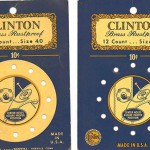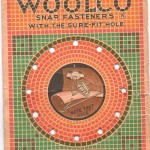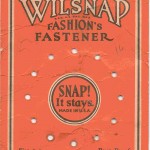(H)at Long Last
December 7th, 2012
*Lest I forget to mention it — you can purchase the hats here*
The pixie hats are done. Finished. Completed. Along with 54 assorted pin-on ribbon & felt flowers. Leaving me only sort of cross-eyed.
Once again, I am left wondering about the D. H. Lawrence connection, but I swear it made sense at the time.

I had a little too much fun adjusting colors on the outdoor shots in Adobe Lightroom …
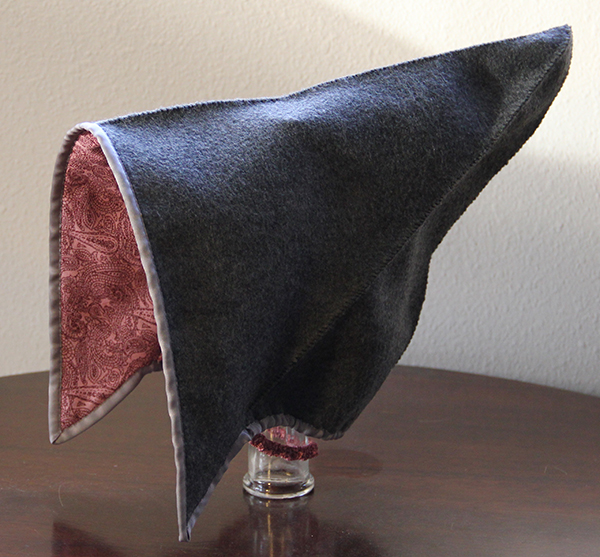
And of course, the all important interior shot, complete with a view of my brand new embroidered labels.
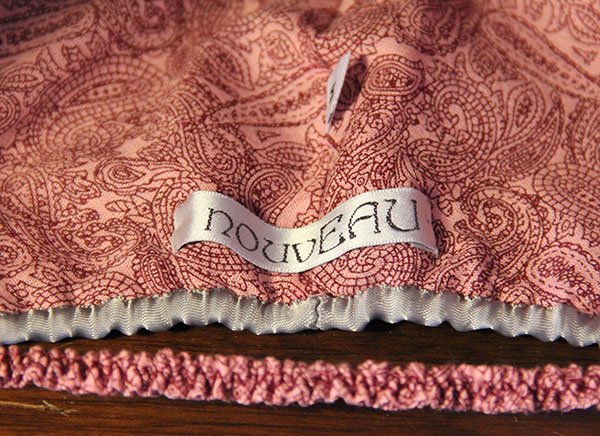
I think it’s fair to say I would never make it in a sweat shop. I tried to find shortcuts to speed up the production of the hats, but in the end sewed the exteriors completely by hand — including the ribbon binding. I like to think it’s because of my exacting standards, but in truth, I’m sort of lousy at machine sewing. Things just turn out better when I do them by hand. Plus I’ve gotten addicted to the control of hand stitching; I can’t understand why my machine balks at 1/4 inch seam allowances.
First Armistice Blouse
December 6th, 2012
To be honest, I don’t really know when or why this early 20th-century blouse style came to be called “Armistice.” It’s probably due to their great popularity during World War I. Whatever you call them, I think these delicate blouses are the perfect blend of Edwardian elegance and art nouveau flair.
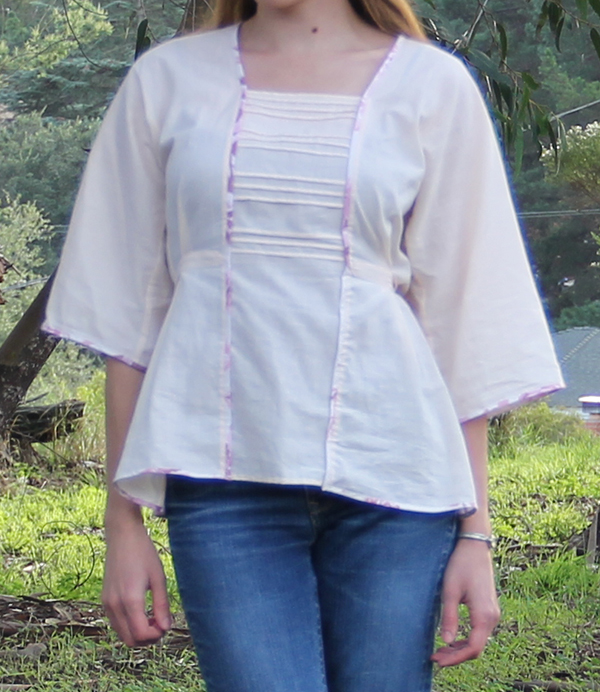
I don’t have a picture of a period Armistice blouse handy, but you can easily find one on Google if you aren’t already familiar with the form (recently re-popularized by Downton Abbey). There’s also a classic Folkwear pattern for the Armistice blouse style. It’s reviewed here, on one of my favorite blogs.
My first attempt is rather deconstructed. I kept the basic bodice front, with an inset panel forming the trademark square neckline. I also included a waist tie, though mine goes backwards instead of forwards (originally, the tie was meant to contain the blouse when it was tucked into a skirt). I left off the collar though, and cut it with kimono sleeves. And, since it’s so loosely fitted, I didn’t bother with a front side opening.
It’s incredibly comfortable to wear, and was pretty darn easy to put together. I didn’t even make a pattern. Just measured and cut. But now that I see it in a picture, I have to admit it does project a certain frumpiness…the next version is already underway, and should be much more delicately styled.
Oh, and once I get it right, I intend to make enough to share! They’ll be in my newly opened Etsy shop. Yes, I too have succumbed.
A Little Tatty
December 5th, 2012
No pictures yet of my recent love affair with the armistice blouse, but here’s a sneak peek in the form of tatted edging.
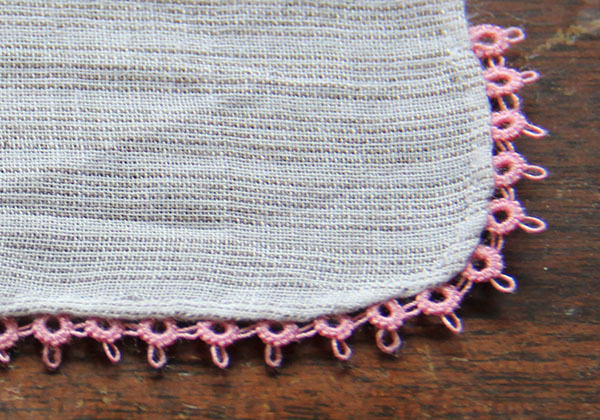
This is the collar that will soon be attached to my latest blouse. You can’t see it terribly well in the picture, but the fabric is a nearly sheer white with pale grey pin stripes. I used pink cotton for handkerchief hemming and fagotting, so naturally had to whip up a few lengths of pink tatted edging to match. It’s an embarrassingly simple pattern (I have yet to quite master the whole two-shuttle thing), but at least it works up relatively quickly.
And it’s such fun taking my tatting around with me. Everyone is always curious about what I’m doing.
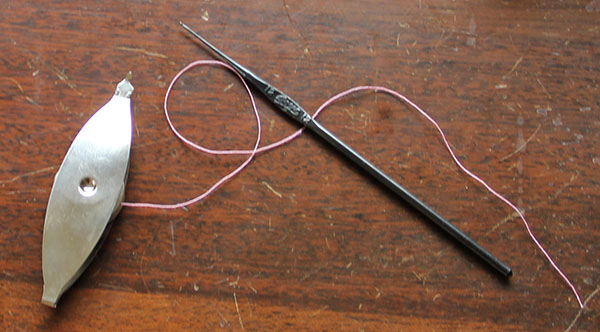
According to some histories I’ve read, tatting was developed centuries ago by nuns. Is it just me, or was all needlework developed by nuns? They say it caught on in the European courts when the ladies in waiting (always eager for something tasteful to pass the time) discovered how well tatting showed off their taper fingers* as they tied all those teeny knots. Elaborate and richly decorated shuttles of precious metal or ivory were de rigueur up through the Victorian era. I purchased a reproduction sterling silver filigree shuttle myself a few years ago, but was dismayed to find it stained my thread with tarnish. Perhaps a bath in lemon juice…
But really, it’s easier to stick to the mid-20th century metal ones, with their handy little bobbins that pop in and out. They even have a hook on the end for picking up the picots — though I find it works much better with a crochet hook. My absolute favorite shuttle is red plastic, without a separate bobbin (they can sometimes unwind at inconvenient moments) but I can’t seem to put my finger on its present location.
*Taper fingers is a ridiculously overused, semi-erotic 19th-century phrase — sort of the “heaving bosoms” or “throbbing member” of a more decorous time. For example, from Tom Cringle’s Log, circa 1832: “Then again—as I praised his lovely taper fingers—they were more like bunches of frosted carrots, dipped in a tar-bucket, with the tails snapt short off…”
Snap
December 4th, 2012
Moving out of our teensy Greenwich Village garret and into a relatively cavernous cottage on the California coast has been quite the process. Among the great changes: we finally have all of our possessions in one place; no longer are they stashed in other people’s attics and closets. For me, that means a veritable mountain of needlework supplies. Not only my own accumulations from the past decade, but also a fair stash inherited from my grandmother — not to mention a series of generous gifts passed down from friends and neighbors.
Recently, in the midst of negotiating a fantastic bunch of old notions into the antique wardrobe which is temporarily housing my ribbon, lace, and fasteners, I came across these glorious snap cards. Each was holding only one or two metal snaps, and it seemed a waste of space to store them so. Since the vintage snaps are virtually indistinguishable from their modern counterparts (nice to know some things haven’t changed), I consolidated onto a more recent card, leaving these beauties as you see them.
Based on some very cursory research, it seems that metal snap fasteners were introduced in the late 19th century. You certainly see enough of them on early 20th century clothing — and not just casual wear. They are widely used on gowns, dresses, blouses, skirts — anywhere that a hook and eye might have shown up a few decades earlier. Snaps have the added advantage of not requiring tension to keep them closed (like hook and eye fasteners do), so they were well suited to the looser styles that evolved following World War I. They come in a handful of sizes — the smallest being 4-0, recommended for delicate sheer fabrics, like lawn or batiste.
Given my current penchant for armistice blouses (more on that shortly), you can bet I’m digging the snap of late. Plus these gorgeous deco cards!
Mythology
December 3rd, 2012
Note – I am conveniently ignoring the fact that this is my first posting in nearly two months.
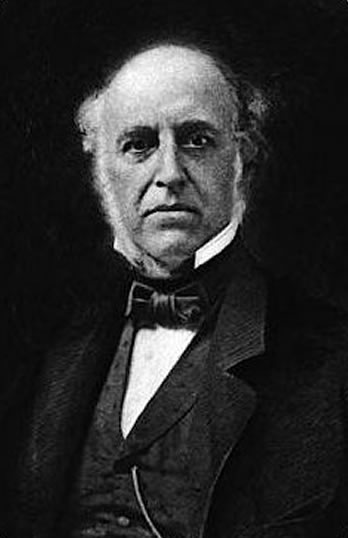
This is an engraving of Thomas Bulfinch. His texts on mythology (classical, Arthurian, and romantic) were published in the mid-19th century and remain standards to this day. Geared towards the students of yesteryear, they are engaging, illustrative, and thoroughly enjoyable. Of particular value are the examples he gives from English literature, mostly poetry, pointing out obscure references to the myths under discussion. There were some passages from Milton that I never would have recognized as mythical. I’m not sure yet if Milton’s newly revealed predilection for the Greeks does anything to soften my opinion of him as a priggish misogynist, but it makes me think a little better of De Quincey and Wordsworth (who both idolized Milton).
I’m on a quest to supplement my classical education, sadly lacking in today’s American schools. Though I have no idea what I might have learned about the Greeks and Romans had I not quit traditional high school, I certainly didn’t pick up very much during my preceding years in the public system. All I know of mythology, etc., was acquired from my classically inclined mother during the years when she taught me at home. We studied mythology, art, culture, and Latin as a spoken language…
In addition to Bulfinch, I’ve also been steered towards Robert Graves, but hesitate based on its relative modernity (published in the mid-20th century) and poor reviews. I am however determined to keep a copy of Sir William Smith’s Classical Dictionary (originally published 1844) handy.
Or, maybe if I hurry up and learn to read Latin, I can find some classical authors to add to the mix…
« Newer Posts — Older Posts »
